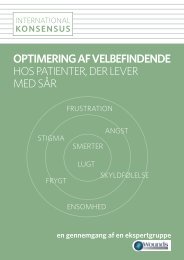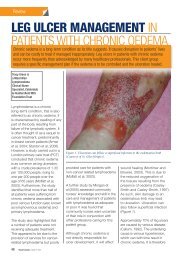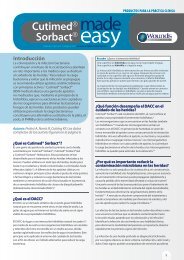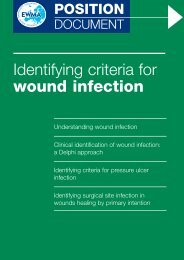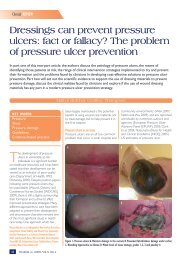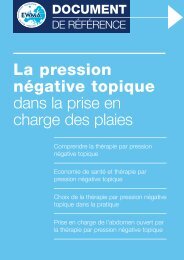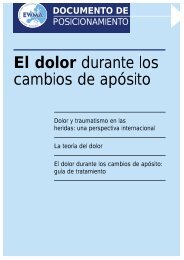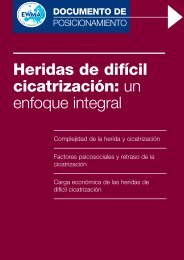template Spanish:template Spanish - Wounds International
template Spanish:template Spanish - Wounds International
template Spanish:template Spanish - Wounds International
You also want an ePaper? Increase the reach of your titles
YUMPU automatically turns print PDFs into web optimized ePapers that Google loves.
FIGURA 11 Linfedema genitalposquirúrgico en una mujer© Földiklinik, Alemania.Reproducido con autorización.FIGURA 12 Varón con linfedemagenital y linfedema unilateral deextremidad inferior Para lahinchazón escrotal es adecuadoun suspensorio.© Földiklinik, Alemania.Reproducido con autorización.compresión. Entre las prendas de compresiónindicadas para los varones con edema deescroto se encuentran los suspensoriosescrotales. Una alternativa útil cuando no setolera una presión elevada son las mallas cortasde ciclismo.Existe un surtido cada vez mayor de prendasde compresión especiales para los pacientescon linfedema del tronco o de los genitales, o deambos.CONCLUSIÓNLas medias de compresión siguen cumpliendouna función importante en el tratamiento dellinfedema de la extremidad inferior. La toma demedidas para las medias debe llevarse a cabocuando el edema depresible es mínimo o nulo.La elección final de la prenda debe tener encuenta la amplia gama de factores del pacientey del linfedema que se han comentado en esteartículo.Se necesitan nuevos estudios que valoren laeficacia clínica y la rentabilidad económica delas prendas de compresión en diferentes gruposde pacientes. De este modo, lasrecomendaciones futuras se basarán eninvestigaciones empíricas y los médicosadquirirán unos conocimientos importantes.BIBLIOGRAFÍA1. Badger C, Seers K, Preston N, Mortimer P. Antibiotics/antiinflammatoriesfor reducing acute inflammatory episodes inlymphoedema of the limbs. Cochrane Database Syst Rev2004; 2: CD003143.2. Badger C, Preston N, Seers K, Mortimer P. Benzo-pyronesfor reducing and controlling lymphoedema of the limbs.Cochrane Database Syst Rev 2004; 2: CD003140.3. Badger C, Preston N, Seers K, Mortimer P. Physical therapiesfor reducing and controlling lymphoedema of the limbs.Cochrane Database Syst Rev 2004; 4: CD003141.4. Murphy MK, Black NA, Lamping DL, et al. Consensusdevelopment methods, and their use in clinical guidelinedevelopment. Health Technol Assess 1998; 2(3): i-iv, 1-88.5. <strong>International</strong> Society of Lymphology. The diagnosis andtreatment of peripheral lymphedema. Consensusdocument of the <strong>International</strong> Society of Lymphology.Lymphology 2003; 36(2): 84-91.6. Moffatt CJ, Morgan P, Doherty D. The LymphoedemaFramework: a consensus on lymphoedema bandaging. In:MODELO PARA LA PRÁCTICA 21European Wound Management Association (EWMA).Focus Document: Lymphoedema bandaging in practice.London: MEP Ltd, 2005: 5-9.7. Twycross R, Jenns K, Todd J (eds). Lymphoedema. Oxford:Radcliffe Medical Press, 2000.8. Royal College of Nursing. Clinical Practice Guidelines: themanagement of patients with venous leg ulcers. London:RCN Institute, 1998.9. British Lymphology Society. Chronic oedema population andneeds. Sevenoaks, Kent: BLS, 1999.10. Morgan PA, Moody M, Franks PJ, et al. Assessingcommunity nurses' level of knowledge of lymphoedema. Br JNurs 2005; 14(1): 8-13.11. Partsch H, Rabe E, Stemmer R. Compression Therapy of theExtremities. Paris: Editions Phlébologiques Francaises, 1999.12. Cameron J. Skin care for patients with chronic leg ulcers. JWound Care 1998; 7(9): 459-62.13. Barlow JH, Wright C, Sheasby J, et al. Self-managementapproaches for people with chronic conditions: a review.Patient Educ Couns 2002; 48(2): 177-87.14. Rockson SG. Lymphoedema after surgery for cancer: therole of patient support groups in patient therapy. HealthOutcomes 2002; 10(6): 345-47.15. Mortimer PS, Levick JR. Chronic peripheral oedema: thecritical role of the lymphatic system. Clin Med 2004; 4(5):448-53.16. Partsch H. Understanding the pathophysiological effects ofcompression. In: European Wound ManagementAssociation (EWMA). Position Document: Understandingcompression therapy. London: MEP Ltd, 2003: 2-4.17. Moffatt CJ, O'Hare L. Ankle pulses are not sufficient todetect impaired arterial circulation in patients with legulcers. J Wound Care 1995; 4(3): 134-38.18. Vowden P, Vowden K. Doppler assessment and ABPI:interpretation in the management of leg ulceration, 2001.www.worldwidewounds.com (accessed March 2006).19. Burns P, Gough S, Bradbury AW. Management of peripheralarterial disease in primary care. BMJ 2003; 326: 584-88.20. Marston W, Vowden K. Compression therapy: a guide tosafe practice. In: European Wound ManagementAssociation (EWMA). Position Document: Understandingcompression therapy. London: MEP Ltd, 2003: 11-17.21. Petrek JA, Lerner R. Lymphedema. In: Harris JR, LippmanME, Morrow M, Hellman S (eds). Diseases of the Breast.Philadelphia: Lippincott-Raven, 1996: 896-903.22. Deutsches Institut für Gütesicherung und KennzeichnungMedizinische Kompressionsstrümpfe RAL-GZ 387. Berlin:Beuth 2000. Available from: www.beuth.de.23. British Standards Institution. Specification for graduatedcompression hosiery. BS 6612:1985. London: BSI, 1985.Available from: www.cenorm.be/catweb.24. Földi M, Földi E, Kubik S (eds). Textbook of Lymphology forPhysicians and Lymphedema Therapists. San Francisco: Urbanand Fischer, 2003.25. Hulpmiddelenkompas. Therapeutische Elastische Kousen.Netherlands, Amstelveen: College voor Zorgverzekeringen,2002. Available at: www.lymfoedeem.nl (accessed March2006).26. Cullum NA, Nelson EA, Fletcher AW, Sheldon TA.Compression for venous leg ulcers. Cochrane Database SystRev 2001; 2: CD000265.OTRAS LECTURASBonham PA. Photo guide: determining the toe brachial pressure index. Nursing 2003; 33(9): 54-55.European Wound Management Association (EWMA). Position Document: Understanding compressiontherapy. London: MEP Ltd, 2003: 11-17.Földi M, Földi E, Kubik S (eds). Textbook of Lymphology for Physicians and Lymphedema Therapists. SanFrancisco: Urban and Fischer, 2003.Gardon-Mollard C, Ramelet A-A. Compression Therapy. Paris, France: Masson SA, 1999.Twycross R, Jenns K, Todd J (eds). Lymphoedema. Oxford: Radcliffe Medical Press, 2000.Vowden K, Vowden P. Doppler and ABPI or LOI in screening for arterial disease. <strong>Wounds</strong> UK 2006; 2(1): 13-16.Vowden P, Vowden K. Doppler assessment and ABPI: interpretation in the management of leg ulceration,2001. Available at: www.worldwidewounds.com (accessed March 2006).




